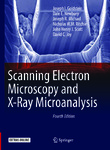Scanning Electron Microscopy and X-Ray Microanalysis

View/
Date
2018Author
Goldstein, Joseph I.
Newbury, Dale E.
Michael, Joseph R.
Ritchie, Nicholas W.M.
Scott, John Henry J.
Joy, David C.
Metadata
Show full item recordAbstract
This is not your father’s, your mother’s, or your
grandparent’s Scanning Electron Microscopy and
X-Ray Microanalysis (SEMXM). But that is not to
say that there is no continuity or to deny a family
resemblance. SEMXM4 is the fourth in the series
of textbooks with this title, and continues a tradition
that extends back to the “zero-th edition” in
1975 published under the title, “Practical Scanning
Electron Microscopy” (Plenum Press, New York).
However, the latest edition differs sharply from
its predecessors, which attempted an encyclopedic
approach to the subject by providing extensive
details on how the SEM and its associated devices
actually work, for example, electron sources, lenses,
electron detectors, X-ray spectrometers, and so on.
In constructing this new edition, the authors have
chosen a different approach. Modern SEMs and the
associated X-ray spectrometry and crystallography
measurement functions operate under such extensive
computer control and automation that it is
actually difficult for the microscopist-microanalyst
to interact with the instrument except within carefully
prescribed boundaries. Much of the flexibility
of parameter selection that early instruments provided
has now been lost, as instrumental operation
functions have been folded into software control.
Thus, electron sources are merely turned “on,” with
the computer control optimizing the operation, or
for the thermally assisted field emission gun, the
electron source may be permanently “on.” The user
can certainly adjust the lenses to focus the image,
but this focusing action often involves complex
interactions of two or more lenses, which formerly
would have required individual adjustment. Moreover,
the nature of the SEM field has fundamentally
changed. What was once a very specialized instrument
system that required a high level of training
and knowledge on the part of the user has become
much more of a routine tool. The SEM is now simply
one of a considerable suite of instruments that
can be employed to solve problems in the physical
and biological sciences, in engineering, in technology,
in manufacturing and quality control, in failure
analysis, in forensic science, and other fields.
